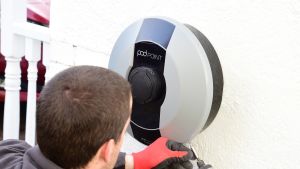A
Auto Express
Guest
For most people, charging at home through a wallbox charger is the easiest way to top up your car’s batteries.
According to the Government’s Go Ultra Low campaign, up to 90 per cent of electric vehicles are charged at home. But it can take a long time to top up your batteries when using a standard domestic plug. So, to speed up the process, many owners invest in a charging unit known as a wallbox.
These discreet wall-mounted (as the name suggests) boxes (again, it’s in the name) can be connected to your existing home electricity supply without too much trouble.
You’ll need some form of off-street parking, but within reason, your new wallbox can be placed exactly where you want it. Better still, there are dozens of units to choose from.
Pick one of the latest ‘smart’ wallboxes and you could be eligible for a government grant of up to £350, allowing you to make best use of off-peak electricity tariffs by programming your car to charge at times when demand on the National Grid is low.
Typically, this will be overnight, effectively allowing you to refuel your car while you sleep. At that cheaper rate, topping up a standard Nissan Leaf could cost as little as £4 – or just over 2p per mile. Most wallboxes will supply alternating current (AC) at a maximum of 7.4kW; a normal three-pin plug is limited to 3kW, although car manufacturers don’t recommend using these long-term, because this can cause damage to the socket due to the high amperage drawn over a sustained period of time.

image

image

image

image

image

image

image

image

image

image

image

image

image

image

image
Faster (up to 22kW) three-phase set-ups are available if your home circuit will allow, but the idea of rapid direct current (DC) charging is almost exclusively reserved for public charging stations – for the time being, at least – where speeds of 50 or 100kW are common, and figures of up to 350kW are possible.
All wall chargers come with either a Type 1 or Type 2 cable. It’s more likely to be the latter, because these are currently accepted by all PHEVs and EVs sold in the UK. Once you’ve checked the cabling will fit, it’s time to look at how fast you’d like your car to charge. Think about how you intend to use the charger, cross-referencing with the size of the battery fitted to your car. A plug-in hybrid will charge fully overnight on a 7kW charger, while some larger-battery EVs may need longer.
The higher the power, the more the unit will cost. Wallbox providers will also arrange installation, and this process is usually included in the price. One company says 90 per cent of customers qualify for free standard installation, although some will need to pay extra.
You’ll need to satisfy a series of safety checks, but once that’s complete, a certified technician can usually get your wallbox set up in a few hours. From here, you’ll be able to charge your car quickly and easily when you’re at home.
How does the home wallbox charger installation work?

image

image

image

image

image

image

image

image

image

image

image

image

image

image

image
What home charger grants and tax breaks are available?
New EVs costing less than £50,000 are eligible for the government’s £3,000 plug-in car grant. Yet whether you buy new or used, plug-in hybrid or fully electric, you can also apply for a government subsidy towards the cost of a home wallbox. There are a few criteria you must meet, but if you tick the boxes, it could make charging your low-emissions model quicker, cheaper and more convenient.
The Office for Low Emission Vehicles (OLEV) oversees the grant, which will cover 75 per cent (up to the value of £350) of the cost of buying and installing a ‘smart’ wallbox charger. These cost from around £300, and let you take advantage of cheaper off-peak electricity tariffs.
Find out about the best public charge point providers in the uk here...
Continue reading...
According to the Government’s Go Ultra Low campaign, up to 90 per cent of electric vehicles are charged at home. But it can take a long time to top up your batteries when using a standard domestic plug. So, to speed up the process, many owners invest in a charging unit known as a wallbox.
- SEE MORE Best electric cars to buy 2020
These discreet wall-mounted (as the name suggests) boxes (again, it’s in the name) can be connected to your existing home electricity supply without too much trouble.
You’ll need some form of off-street parking, but within reason, your new wallbox can be placed exactly where you want it. Better still, there are dozens of units to choose from.
Pick one of the latest ‘smart’ wallboxes and you could be eligible for a government grant of up to £350, allowing you to make best use of off-peak electricity tariffs by programming your car to charge at times when demand on the National Grid is low.
Typically, this will be overnight, effectively allowing you to refuel your car while you sleep. At that cheaper rate, topping up a standard Nissan Leaf could cost as little as £4 – or just over 2p per mile. Most wallboxes will supply alternating current (AC) at a maximum of 7.4kW; a normal three-pin plug is limited to 3kW, although car manufacturers don’t recommend using these long-term, because this can cause damage to the socket due to the high amperage drawn over a sustained period of time.

image

image

image

image

image

image

image

image

image

image

image

image

image

image

image
Faster (up to 22kW) three-phase set-ups are available if your home circuit will allow, but the idea of rapid direct current (DC) charging is almost exclusively reserved for public charging stations – for the time being, at least – where speeds of 50 or 100kW are common, and figures of up to 350kW are possible.
All wall chargers come with either a Type 1 or Type 2 cable. It’s more likely to be the latter, because these are currently accepted by all PHEVs and EVs sold in the UK. Once you’ve checked the cabling will fit, it’s time to look at how fast you’d like your car to charge. Think about how you intend to use the charger, cross-referencing with the size of the battery fitted to your car. A plug-in hybrid will charge fully overnight on a 7kW charger, while some larger-battery EVs may need longer.
The higher the power, the more the unit will cost. Wallbox providers will also arrange installation, and this process is usually included in the price. One company says 90 per cent of customers qualify for free standard installation, although some will need to pay extra.
You’ll need to satisfy a series of safety checks, but once that’s complete, a certified technician can usually get your wallbox set up in a few hours. From here, you’ll be able to charge your car quickly and easily when you’re at home.
How does the home wallbox charger installation work?
- Handover - Your wallbox supplier will arrange for your unit to be delivered
- Fitting - The installer will drill through the outside wall to allow the wallbox to be connected to the electric supply
- Connected - Your new wallbox is wired into the household mains via the consumer unit
- Features - Most wallboxes have WiFi connections to let you monitor usage, Units made after 1 January, 2019, have a ‘fuse saver’ to prevent circuits from tripping
- In control - Connecting your wallbox to the internet will let you monitor how much electricity you’re using and how much it is costing you to charge your car

image

image

image

image

image

image

image

image

image

image

image

image

image

image

image
What home charger grants and tax breaks are available?
New EVs costing less than £50,000 are eligible for the government’s £3,000 plug-in car grant. Yet whether you buy new or used, plug-in hybrid or fully electric, you can also apply for a government subsidy towards the cost of a home wallbox. There are a few criteria you must meet, but if you tick the boxes, it could make charging your low-emissions model quicker, cheaper and more convenient.
The Office for Low Emission Vehicles (OLEV) oversees the grant, which will cover 75 per cent (up to the value of £350) of the cost of buying and installing a ‘smart’ wallbox charger. These cost from around £300, and let you take advantage of cheaper off-peak electricity tariffs.
Find out about the best public charge point providers in the uk here...
Continue reading...
